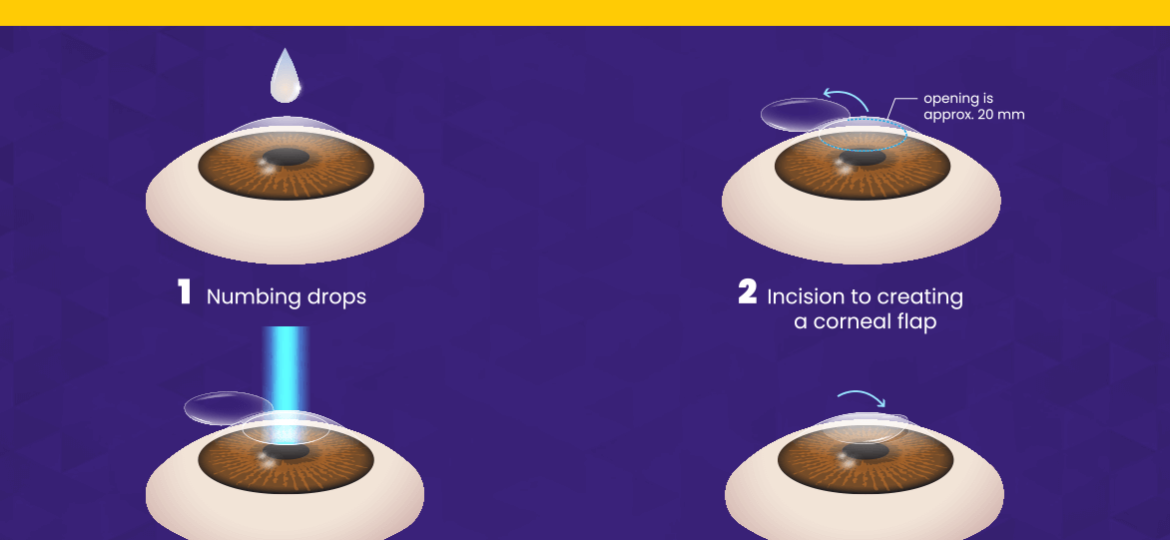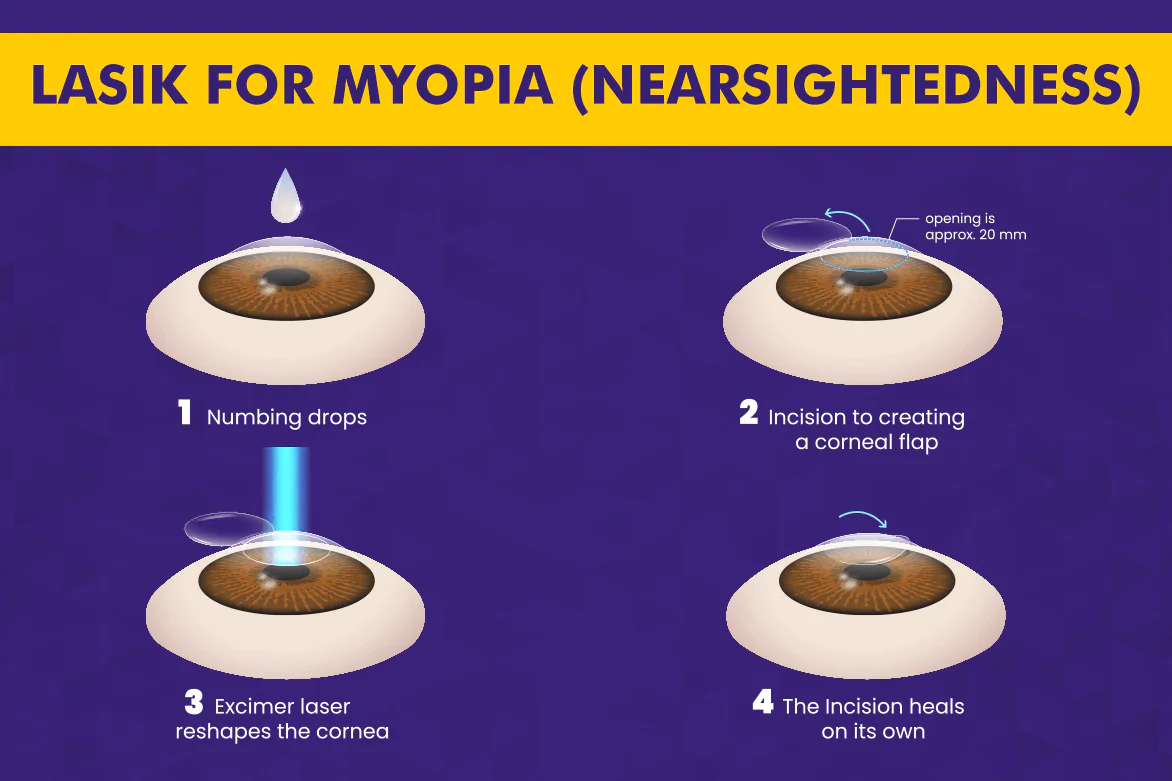
LASIK Eye Surgery for Myopia (Nearsightedness)

For those navigating life with myopia, or nearsightedness, everyday moments are often experienced through the barrier of glasses or contact lenses. Glasses fogging up while sipping hot coffee, the routine hunt for misplaced spectacles, and the daily inconvenience of removing contact lenses are all too familiar. Yet, what if there was a way to step out of this blur and into clarity? Enter LASIK myopia treatment, a light of hope for many looking to move past the inconvenience of myopia and embrace a life without glasses and lenses.
Let’s further cover what Myopia is, how LASIK myopia treatment works, risks and side effects of LASIK, and much more.
Can LASIK Help Treat Nearsightedness?
Yes, LASIK for nearsightedness can be very effective. This effectiveness is achieved through a precise and controlled laser procedure that reshapes the cornea—the transparent front part of the eye. In myopia, the cornea is usually too curved or the eye is too long, causing light to focus in front of the retina instead of directly on it, which results in blurred distance vision. The LASIK myopia treatment specifically targets this issue by flattening the cornea just the right amount, allowing for light to be properly focused onto the retina. Many patients who undergo LASIK myopia surgery experience significant improvements in their vision, often gaining the ability to see clearly at a distance without the need for glasses or contact lenses. This makes LASIK myopia a popular choice for those seeking a long-term solution to nearsightedness.
How Does LASIK Treat Myopia?
During LASIK treatment for myopia, a specialized laser is used to slightly flatten the cornea, allowing light rays to focus more directly on the retina, thereby improving distance vision. The procedure is quick, typically taking about 10 to 15 minutes for both eyes, and is performed under local anesthesia to minimize discomfort. Most patients notice a significant improvement in
their vision almost immediately after LASIK eye surgery for nearsightedness, and this improvement can be life-changing, reducing or even eliminating their dependence on glasses or contact lenses for distance vision.
LASIK treatment for myopia (Laser-Assisted In Situ Keratomileusis) treats nearsightedness through a detailed, step-by-step process that reshapes the cornea to correct the way light is focused onto the retina. Here’s a step-by-step guide on how LASIK eye surgery for nearsightedness treats myopia:
Before the LASIK Procedure
- Consultation and Evaluation: A thorough eye examination to assess suitability, including corneal thickness, eye health, and vision stability.
- Instructions: Patients are generally advised to stop wearing contact lenses for a period before surgery to ensure the cornea is in its natural shape.
- Preparation: On the day, patients should avoid makeup or lotions around the eyes to reduce infection risk.
During the LASIK procedure
- Anesthetic Drops: Before the LASIK eye surgery for nearsightedness begins, the application of numbing drops is done to the eye to ensure comfort throughout the surgery.
- Eye Positioning: The patient is positioned under the laser microscope, and an instrument called a lid speculum is used to keep the eyelids open.
- Corneal Flap Creation: A precise instrument, either a microkeratome or a femtosecond laser, is used to create a thin flap in the cornea’s surface layer. This flap is carefully lifted and folded back to expose the underlying corneal tissue.
- Reshaping the Cornea: With the corneal tissue exposed, the surgeon uses an excimer laser to remove microscopic amounts of tissue from the cornea. For myopia, the laser flattens the cornea’s curve, allowing light rays to focus more directly on the retina rather than in front of it.
- Corneal Flap Repositioning: After the cornea has been reshaped, the surgeon carefully repositions the corneal flap back into its original place. This flap adheres naturally and heals over time without the need for stitches.
- Completion: Once the corneal flap is securely in place, the procedure is complete. The laser treatment itself only takes a few seconds to a minute per eye, depending on the amount of correction needed.
This laser procedure, LASIK eye surgery for nearsightedness, effectively corrects myopia by adjusting the corneal shape for clearer, more focused vision.
After the LASIK Procedure
- Immediate Post-Op: Patients often rest briefly in the clinic and wear protective eyewear. Vision may be blurry or hazy initially.
- Follow-Up Visits: Check-ups to monitor healing and vision improvement are scheduled.
- Eye Care: Use prescribed eye drops to prevent infection and inflammation. Avoid rubbing eyes and participating in contact sports for a short period.
- Vision Stabilization: Vision typically improves within a day, with further stabilization over the following weeks to months.
What is Myopia (nearsightedness)?
Myopia, or nearsightedness, means you can see things clearly when they’re close to you, but objects farther away look blurry. This happens because the shape of your eye makes light focus in the wrong place, not directly on your eye’s screen (the retina). It’s like when a camera doesn’t focus right, and the picture comes out fuzzy.
LASIK myopia treatment uses a laser to precisely reshape the cornea. During LASIK for myopia, a doctor uses a special laser to reshape the front part of your eye (the cornea) so that light focuses exactly where it should. This makes distant objects look clear and sharp again. It’s a way to get clearer vision without needing glasses or contacts.
How common is Myopia (Nearsightedness)?
Myopia, or nearsightedness, is incredibly common and is becoming more so. Studies show that about 40% of people in the India have myopia. This means if you walk into a room, it’s likely that a third of the people there will have trouble seeing things far away clearly without glasses or contacts. With more time spent indoors and on screens, the number of people with myopia keeps going up. It’s a major reason why many people need glasses or contacts to see clearly.
For those looking for a long-term solution to this issue, LASIK for nearsightedness offers a promising option. By reshaping the eye’s surface with a laser, LASIK treatment for myopia can correct the focus.
Side Effects of LASIK for Myopia
LASIK for nearsightedness can really change your life by improving your vision, but like any surgery, it comes with some risks of side effects and complications. Here are some side effects and complications that can happen after LASIK myopia surgery:
- Your eyes might feel dry than usual for a few months after surgery.
- You might see bright circles around lights, especially at night.
- Sometimes, the surgery might not remove enough or might remove too much tissue, affecting how well you can see without glasses.
- Your vision might change or be less clear during the first few weeks or months.
- You might notice double vision or shadows on images, especially in dim light.
- Although rare, there’s a small risk of infection after the surgery.
- Problems with the flap made during surgery can lead to less clear vision.
- Over time, your vision might slowly return toward your original prescription, although this is not very common.
- Very rarely, the surgery could lead to loss of vision that can’t be corrected with glasses or contacts.
Suitable Candidates for LASIK Myopia Surgery
Determining if you’re a good candidate for LASIK for nearsightedness is an important step before considering the procedure. LASIK for myopia can offer a permanent solution to nearsightedness, allowing you to enjoy life without the constant reliance on glasses or contact lenses. However, LASIK for high myopia is not suitable for everyone. Several key factors need to be taken into account to ensure the best outcomes and minimize risks. Here are some criteria that typically make someone a good candidate for LASIK:
- At least 18 years old, with some doctors recommending over 21 for greater stability in vision.
- A stable eye prescription for at least the last year.
- No eye diseases, corneal abnormalities, or severe dry eye syndrome.
- Enough corneal thickness to allow for the reshaping.
- Good overall health without conditions that can affect healing, like autoimmune diseases.
- Understanding both the potential benefits and the limitations or risks of LASIK.
Is LASIK Surgery for Nearsightedness Right for You?
Deciding if LASIK for nearsightedness is right for you involves considering your vision goals, understanding the procedure’s benefits and risks, and evaluating your health and lifestyle. If you’re tired of glasses or contacts and seek a long-term solution for clear vision, LASIK for nearsightedness might be a great option, provided you meet the candidacy criteria like stable vision, healthy eyes, and sufficient corneal thickness.
It’s crucial to have realistic expectations about the eye operation for myopia and to be aware of potential side effects and complications. Not everyone achieves perfect vision, and some may still need glasses for certain activities.
The best way to determine if LASIK for high myopia is right for you is to consult with an experienced eye doctor. They can assess your specific situation, discuss the risks and benefits, and help you make an informed decision. Remember, it’s about enhancing your quality of life, so take the time to weigh all factors carefully.
Alternative to LASIK for Nearsightedness
For those considering options beyond LASIK for nearsightedness, there are several alternatives. PRK (Photorefractive Keratectomy) also uses a laser to reshape the cornea but doesn’t create a flap, making it a good choice for people looking for LASIK for high myopia. LASEK (Laser Epithelial Keratomileusis) is similar but involves a different way of preparing the eye for reshaping. For those not suited to laser procedures, implantable lenses (phakic IOLs) can be placed inside the eye to correct vision. Lastly, for those seeking non-surgical options, glasses and contact lenses remain effective ways to manage nearsightedness. Each alternative has its own set of benefits and considerations, so talking to your eye doctor can help you find the best fit for your eyes and lifestyle.
For those wanting to lead a life free from myopia, LASIK for nearsightedness presents a promising path. Also known as the eye operation for myopia, this procedure is a testament to the wonders of modern medicine, offering a blend of science and magic that can transform lives. As you consider this life-changing decision, envision the world as it could be—vivid, clear, and full of possibility. This isn’t just about seeing better; it’s about living better. Undergoing the eye operation for myopia allows you to embrace clarity, embrace change, and see the world in a whole new light. This eye operation for myopia is more than a medical procedure; it’s a step towards a life unstoppable by the limits of nearsightedness.
FAQs
Can LASIK correct both nearsightedness and farsightedness at the same time?
Yes, LASIK can correct both nearsightedness (myopia) and farsightedness (hyperopia) in the same procedure, tailored to the individual’s eye structure and vision needs.
What are the limits of LASIK for nearsightedness?
While LASIK for nearsightedness is highly effective, extreme myopia cases with very high prescriptions or those with thin corneas may face limitations, as there’s a cap on how much the cornea can be safely reshaped.
How long does the LASIK for nearsightedness procedure take?
LASIK for nearsightedness procedure is notably quick, usually completed in about 10 t0 15 minutes for both eyes.
How much does LASIK for myopia cost?
At Planet Lasik, the cost for LASIK starts from 12,500 per eye only. Visit Planet Lasik for complete pricing.
What is the recovery period after LASIK for myopia?
Most patients undergoing LASIK for nearsightedness or myopia can resume their routine within a day or two, with their vision notably improving and stabilizing across several weeks.
